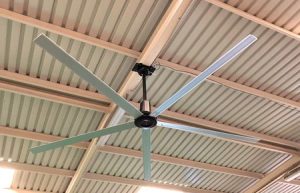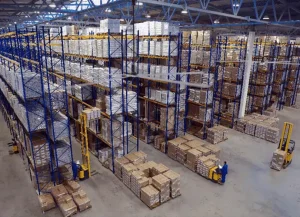Feeling hot and uncomfortable in large spaces like warehouses, factories, and gyms? Poor air circulation can cause heat buildup, reduced productivity, and even safety risks. High-volume low-speed (HVLS) fans solve this problem by improving air movement, ensuring a cooler, more comfortable environment while saving energy.
An HVLS fan (high-volume low-speed fan) is a large industrial ceiling fan that moves a high volume of air at low speed. Typically over 7 feet in diameter, these industrial ceiling fans operate at a low rotational speed, effectively increasing air circulation and maintaining comfortable temperatures.

HVLS Fan in Action
HVLS fans generate airflow through slow, wide blade rotation. Instead of relying on high-speed fans that use excessive energy, HVLS fans move air at low speed, producing a floor jet effect that circulates air efficiently in large spaces like warehouses, gyms, and manufacturing plants.
| Feature | HVLS Fans | Traditional Ceiling Fans |
|---|---|---|
| Size | 7-24 feet in diameter | 3-6 feet in diameter |
| Speed | Low-speed (50-120 RPM) | High-speed (200+ RPM) |
| Airflow | Covers 20,000+ sq. ft. | Limited coverage |
| Energy Efficiency | High (reduces HVAC costs) | Less efficient |
| Usage | Industrial & commercial | Residential |
HVLS fans are designed to move air efficiently, reducing dependence on HVAC systems, while traditional residential ceiling fans are optimized for smaller spaces.
HVLS fans provide significant operational advantages, especially in industrial spaces.
HVLS fans are useful in many commercial and industrial applications, including:

Logistics of HVLS Fans
A distribution center with installed HVLS fans cut cooling costs by 40%. With better air movement, employees reported higher productivity and reduced heat stress.
When selecting an HVLS ceiling fan, consider:
How do HVLS fans cool people?
HVLS fans cool people by increasing air movement, creating a gentle cooling effect. They do not lower air temperature but make spaces feel cooler through improved airflow.
What is the difference between HVLS fans and home ceiling fans?
Home ceiling fans are smaller (3-6 feet in diameter) and work in residential spaces, while HVLS fans are larger (7-24 feet) and designed for industrial applications.
Can HVLS fans be combined with HVAC systems?
Yes! HVLS fans increase air circulation and help HVAC systems operate more efficiently, reducing heating and cooling costs.
What is the lifespan of an HVLS fan?
A high-quality HVLS ceiling fan lasts 10-20 years with proper maintenance.
✅ HVLS fans move a high volume of air efficiently
✅ Lower energy consumption = cost savings
✅ Reduce heat stress and improve air quality
✅ Enhance safety and productivity in large spaces
✅ Perfect for warehouses, commercial facilities, and gyms
Contact us today for expert advice and custom HVAC solutions tailored to your needs! 🚀

Hi, I’m Michael Danielsson, CEO of Vindus Fans, with over 15 years of experience in the engineering and design industry. I’m here to share what I’ve learned. If you have any questions, feel free to contact me at any time. Let’s grow together!